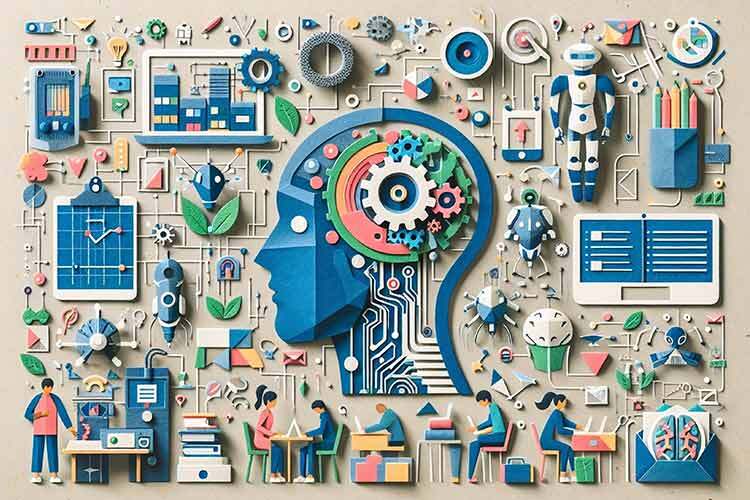Introduction
The creator economy is no longer an emerging niche; it’s a global economic powerhouse. Millions of individuals are now full-time content creators, building businesses around their passions and expertise. However, this explosive growth has also intensified the competition, demanding a relentless pace of high-quality content production. Creators often find themselves bogged down by the time-consuming and technically demanding tasks of ideation, scripting, shooting, editing, and distribution. This is where a new, transformative force is entering the scene: Artificial Intelligence. Major platforms and third-party developers are now rolling out a suite of sophisticated AI-powered tools designed specifically for creators. These tools are not just incremental improvements; they represent a fundamental paradigm shift in the creative process. This article provides a comprehensive technical deep-dive into this new wave of AI for creators, exploring the specific tools, the underlying technology, their profound implications for the industry, and best practices for leveraging them to stay ahead of the curve. This evolution is a significant part of the broader trends seen in AI Tools for Creators News and is closely linked to advancements in AI Phone & Mobile Devices News, as much of this creation happens on the go.
The New Arsenal: Unpacking AI-Powered Creator Tools
The latest generation of AI tools for creators moves beyond simple filters or basic analytics. They are deeply integrated into the creative workflow, acting as intelligent assistants that can handle complex, time-consuming tasks. This allows creators to offload the technical grunt work and focus more on what they do best: connecting with their audience through compelling stories and unique perspectives. These tools can be broadly categorized across the key stages of content production.
From Idea to Inspiration: AI for Content Ideation
The dreaded “creator’s block” can halt momentum in its tracks. AI ideation tools are designed to be a perpetual source of inspiration. By analyzing massive datasets—including trending topics within a niche, competitor content, search engine queries, and a creator’s own audience comments—these AI systems can generate tailored content ideas. For example, an AI assistant might suggest a video topic like “A Deep Dive into the AI in New Smart Appliances” for a tech reviewer, complete with a suggested outline, key talking points, and relevant keywords. This goes beyond simple trend-spotting; it’s a predictive analysis of what an audience wants to see next. This is a prime example of how AI Assistants News is evolving to serve specialized professional fields.
Streamlining Production: AI in Video and Audio Editing
Editing is arguably the most labor-intensive part of content creation. AI is making its most significant impact here. New tools can automatically perform tasks that once took hours of meticulous manual work. Consider a “talking head” video; AI can now listen to the audio track, automatically identify and remove filler words (“ums,” “ahs”) and awkward pauses, creating a seamless jump-cut edit in seconds. In the realm of audio, advancements highlighted in AI Audio / Speakers News are being applied to provide studio-quality noise cancellation, removing background hum or echo from imperfect recording environments. Furthermore, generative AI can create B-roll footage from a simple text prompt, replace a messy background without a green screen, or even suggest the most emotionally resonant clips from hours of raw footage, a development straight from the pages of AI-enabled Cameras & Vision News.
Breaking Language Barriers: AI-Powered Dubbing and Translation
Expanding to a global audience has traditionally required expensive and complex localization efforts. AI-powered dubbing is set to demolish this barrier. Using advanced voice cloning technology, these tools can analyze a creator’s unique voice—its pitch, timbre, and cadence—and then synthesize a new audio track in a different language that sounds remarkably like the original speaker. A creator can record a video in English, and the platform’s AI can generate authentic-sounding dubs in Spanish, Japanese, or Hindi, instantly making the content accessible to millions of new viewers. This feature alone has the potential to dramatically reshape content distribution strategies on a global scale.

Under the Hood: How AI is Redefining the Creative Workflow
The magic of these creator tools is powered by several converging fields of artificial intelligence research. Understanding the technology underneath provides a clearer picture of their capabilities and limitations. These advancements are not isolated; they are part of a wider technological push also seen in fields like Robotics News and AI Edge Devices News, where processing power and intelligent algorithms are being pushed to new frontiers.
Generative Video and Image Synthesis
Features like AI-generated B-roll or background replacement are powered by generative models, primarily diffusion models and Generative Adversarial Networks (GANs). A diffusion model works by starting with random noise and gradually refining it, step-by-step, to match a text description (a “prompt”). This is how a creator can type “cinematic shot of a futuristic city at sunset” and receive a unique video clip. This technology, which has parallels in AR/VR AI Gadgets News for creating virtual environments, allows for the creation of visual assets that are not just royalty-free but entirely novel, offering limitless creative possibilities.
Natural Language Processing (NLP) for Content Analysis
Natural Language Processing is the engine behind AI-driven editing, ideation, and summarization. When an AI tool automatically removes filler words, it’s using an NLP model trained to recognize speech patterns and linguistic context. When it suggests video ideas based on audience comments, it’s performing sentiment analysis and topic modeling on thousands of text entries. This same core technology is used in a vast array of applications, from powering the interfaces in Smart Home AI News to analyzing data in Health & BioAI Gadgets News, demonstrating its incredible versatility.
Voice Cloning and Synthesis for Global Reach
AI dubbing relies on a sophisticated two-step process. First, a voice cloning model, often a type of neural network called a vocoder, is trained on a small sample of the creator’s speech to capture its unique characteristics. Second, a text-to-speech (TTS) engine takes a translated script and uses the cloned voice model to generate the new audio track. The key innovation is the ability to preserve emotional inflection and personal speaking style, moving far beyond the monotonous robotic voices of the past. The ethical implications are significant, and platforms are implementing digital watermarking and strict usage policies to prevent misuse, a challenge also being tackled in the AI Security Gadgets News space.
The Ripple Effect: Implications for the Creator Economy and Tech Landscape
The integration of these powerful AI tools is not just changing individual workflows; it’s sending shockwaves through the entire creator economy and the broader tech ecosystem. The effects are complex, presenting both unprecedented opportunities and new challenges that creators must navigate.

Democratization vs. Homogenization
On one hand, AI is a powerful democratizing force. By automating complex technical tasks, it lowers the barrier to entry for creating professional-looking content. An aspiring creator with a great idea but limited budget or editing skills can now produce videos that rival those of established studios. This aligns with trends in AI for Accessibility Devices News, where technology empowers more people to participate fully. However, there is a risk of creative homogenization. If too many creators rely on the same AI for topic suggestions, script outlines, and editing styles, content could begin to feel formulaic and lose the unique, authentic voice that audiences crave.
The Shifting Skillset of a Modern Creator
As AI handles more of the technical execution, the definition of a “skilled creator” is evolving. Proficiency in complex editing software may become less critical, while other skills rise in importance. The ability to craft effective prompts to guide generative AI—a skill known as prompt engineering—will be crucial. Strategic thinking, creative direction, and the ability to curate and refine AI-generated outputs to fit a personal brand will become the new differentiators. The creator’s role shifts from a hands-on technician to that of a creative director, orchestrating a collaboration between human vision and artificial intelligence. This mirrors shifts in other industries, from AI in Fashion / Wearable Tech News to AI Kitchen Gadgets News, where human curation guides AI execution.
Integration with the Wider AI Ecosystem
The content created with these tools will not exist in a vacuum. It will be consumed across a rapidly evolving ecosystem of AI-driven devices. Imagine content created for in-cabin entertainment systems, a topic of interest in Autonomous Vehicles News, or interactive educational content for devices featured in AI Education Gadgets News. The metadata and structure generated by these AI tools could make content more discoverable and adaptable for AI Personal Robots or smart displays, fundamentally changing how media is distributed and experienced.

Practical Guidance: Best Practices and Navigating the Pitfalls
To successfully integrate these new technologies, creators need a strategic approach. Simply adopting every new tool is not a recipe for success. It requires a thoughtful balance of leveraging AI’s power while preserving the human element that builds a loyal community.
Best Practices for Leveraging Creator AI
- Use AI as a Co-pilot, Not an Autopilot: The most effective approach is to view AI as a creative partner. Use it to brainstorm initial ideas, but apply your own unique spin. Let it handle the tedious first pass of an edit, but then perform the final polish yourself to ensure the pacing and tone are perfect.
- Master the Art of the Prompt: The quality of AI-generated output is directly proportional to the quality of the input. Learn to write clear, descriptive, and nuanced prompts to get the best results from generative video or image tools. Experiment with different phrasing and parameters.
- Maintain Authenticity: Your unique personality is your most valuable asset. Before publishing any AI-assisted content, ask yourself: “Does this still sound and feel like me?” Tweak AI-generated scripts and review AI edits to ensure your authentic voice shines through.
Common Pitfalls to Avoid
- Over-reliance and Creative Atrophy: Becoming too dependent on AI for content ideas can weaken your own creative muscles. Continue to engage with your community, stay curious, and develop your own ideas. Use AI as a supplement, not a replacement, for your own creativity.
- Copyright and Ethical Blind Spots: The legal landscape around AI-generated content is still evolving. Be aware of your platform’s terms of service regarding the use of AI tools. Be transparent with your audience about your use of AI, especially with technologies like voice cloning, to maintain trust.
– Ignoring the Uncanny Valley: Be wary of AI-generated visuals or voices that are “almost” perfect. Audiences are highly sensitive to content that feels slightly off or inauthentic, which can break trust. Always review and, if necessary, discard AI assets that don’t meet a high quality bar.
Conclusion: The Dawn of the AI-Augmented Creator
We are at the dawn of a new era in content creation—one defined by the collaboration between human creativity and artificial intelligence. The new suite of AI-powered tools being integrated into major platforms promises to streamline workflows, break down language barriers, and unlock new creative possibilities. For creators, this is not a threat but an opportunity. The core of successful content creation—authenticity, storytelling, and community connection—remains unchanged. However, the tools used to bring those stories to life are becoming exponentially more powerful. The future of the creator economy will be led by those who can master this new toolkit, using AI not as a crutch, but as a catalyst to amplify their unique vision and connect with audiences on a truly global scale. This trend is a cornerstone of current AI Tools for Creators News and will undoubtedly influence everything from AI in Gaming Gadgets News to the future of personal media.










